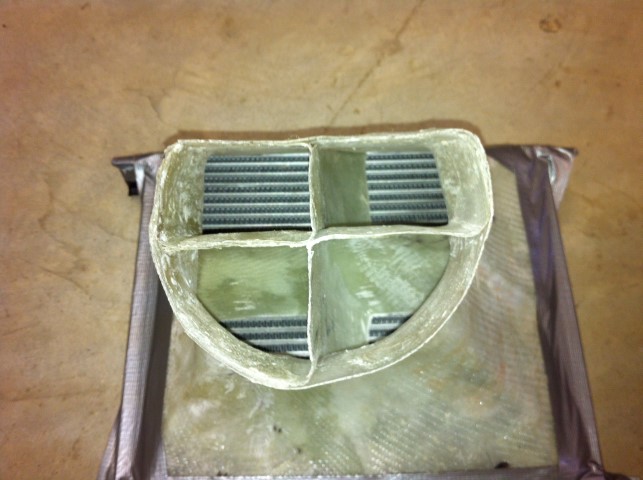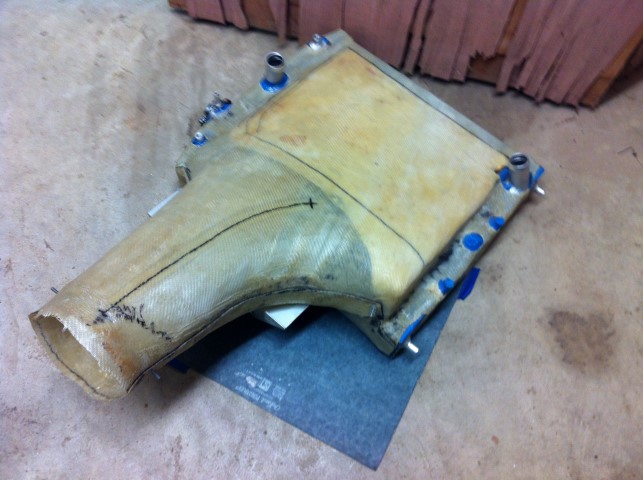|
|
Some
historical docs about the P51 say that one reason for
placing the diffuser inlet aft under the wing (instead of
near the prop) is to minimize pressure pulses from the prop.
Each pulse from a blade causes in increase of pressure, but
it also slightly compresses the air in the duct, which then
expands (back out) between pulses, which interferes with
flow, both from the next pulse and from regular flow. On the
other hand, LoPresti (with his 'Holy Cowl') tried to take
advantage of the pulses for *induction*. Remember, induction
is different in that there are huge pressure/flow changes
because of intake valving (whether there are actual valves
in there or not :-) ). He claimed to position the blade/duct
relationship so that pulses arrived at the valve coinciding
with valve opening.
Warning: My
fiberglass work is...ugly.


Pics of my
turning vanes (hopefully) attached. Note that these
diffusers have *not* flown. My testing was similar to
Bobby's, with a leaf blower to feed the diffuser, but no
pressure measurements in the diffuser. I used the
'traditional' method of a thread on a stick, moved around
the exit side of the heat exchanger core, to determine
whether I had fairly consistent flow across the entire core.
I've got a video of the test, but it'll be too big to post
here. I'll try to find a link to a cloud-based source if you
want to see it. The rad turning van is an aluminum blade
which follows the black marker line drawn on the outside of
the diffuser. I had zero flow in the forward bottom 1/4 of
the core before adding the vane (as expected) before adding
the vane, and fairly even flow across the core after adding
the vane. As previously discussed, a 'wedge' diffuser
requires an extreme pinch in the wedge at the aft end, to
keep flow working in the forward 2/3 of the core. If you've
read the K&W chapter on cooling and seen their drawing
of a wedge diffuser, it shows the opposite of my (and
Tracy's) experience in required shape at the aft end of the
wedge. I don't have an explanation for the difference, but I
know that the K&W wedge shape doesn't work with a thin
wedge.
The oil
cooler diffuser is *very* short (~8") and very
asymmetrical (cowl packaging restrictions). I never bothered
to check without the vanes because the duct is so short and
the turns so extreme I knew it would never work without
vanes. Again, never flown, so I have no idea on total
efficiency, but I do know that the core is getting even flow
across its entire face.
Hope that
helps,
Charlie
Matt,
“Bobby, how did you measure the
good airflow? Magnetometers?” I used a large leaf
blower pointed into a 4’ section of 6” tubing
connected to the diffuser inlet. I then used an
anemometer to measure exit air speeds in a grid
pattern of the core.
“Won't your ground cooling be
harder with a belly mount, the further away from the
prop ?” I believe prop blast / airspeed improves
away from the prop root. At the bottom of my cowling
I measured airspeed in the low 22-24 mph range at low
idle. No other supporting data. A large straight exit
should improve ground cooling. The inlet duct
placement on Russell Sherwood’s plane is reported to
have excellent ground cooling with the larger inlet. I
believe my inlet duct would be closer to where Ross
placed his.
My 48# MT (76”) electric prop is
for sale if you need a nose anchor. I’ve come to the
conclusion I can’t use it for the S21.
Bobby
From:
Rotary motors in aircraft [mailto:flyrotary@lancaironline.net]
Sent: Thursday, January 28, 2021 8:11 PM
To: Rotary motors in aircraft
Subject: [FlyRotary] Re: Ross Farnham -
Cooling video
This
summer I will design a wireless circuit board that
can do 6 temperature probes and 6 pressure ports
running off batteries that will send data to cell
phone/laptop for capturing. Give us real data to
test out different diffuser designs.
Charlie, any pictures of your turning vanes? I did a
trumpet to wedge diffuser and I don't (only guessing
here) think the wedge shapes work as well as they
do. Will add some turning vanes to shoot more air
into the front of the rads. You are right that I am
tail heavy and probably can't do a belly mount :( So
the best bet is to get a thicker smaller rad.
Le Roux, I have talked with
Alex a bunch over exit louvers on the side. We are
hoping to tune the exhaust dumping better to help
pull air out of the bottom of the cowl. I don't
see too many exit louvers though on planes. Any
reason for it?
Bobby, how did you measure the good airflow?
Magnetometers? Won't your ground cooling be harder
with a belly mount, the further away from the prop
?
Bruce, how far along are you? The tango might be
tail heavy like mine, have you done a W&B yet?
I am skeptical on P-port = 250hp, very skepataple.
I am 10kts slower than a standard lycoming engine
in the tango 2, even being p-ported.
I
have decided to use a belly mount radiator
on my tango 2. Have been dithering around
for ages without making a decision - Ross's
excellent articles have convinced me to go
with this setup.
I
have decided on 20” x 7” x either 68 mm 0r
81 mm The 68 mm (2 3/4” will give
approximately 385 cubic” the 81 mm approx
455 cubic “ which is around Neil’s
recommendation. I have a P Lamar designed
radiator which he was confident would cool
up to 250 hp (two 1/2 “ wide cores adding up
to 330 cubic “ so hopefully the thinner 68mm
core should be okay given the lower drag and
straight through flow characteristics I am
looking at around 63 “ length for the pod to
improve flow characteristics - All
constructive input welcome I am not sure
about the best external shape! a very rough
sketch is attached
On 28 January 2021 at 12:07:13, Matt Boiteau
mattboiteau@gmail.com (flyrotary@lancaironline.net)
wrote:
Ross does the
SDS EFI system and did 2 videos on
cooling his Subaru engine.
https://www.youtube.com/watch?v=GGXXEgqhmmc&ab_channel=rv6ejguy
It seems
him and Tracy agree that we need a
thicker core, then the 1" Paul L kept
on suggesting. My coolant rad is
almost as wide as the plane with the
1" truck core.
I'm definitely not happy with my
cooling setup, but needed to get
moving and finish the plane. Can sit
around all day talking about it, or
start with something and get better in
time. I'm done the flyoff hours in FL
and hoping to bring the plane back to
Canada in the spring where I can
tinker with it then. 3D draw things
out and get suggestions from people
then.
What do you guys think of a belly
mount coolant rad? How would we plum
the exhaust out of the way? Keep oil
coolant in the cowl? Or Below the
engine?
--
Homepage:
http://www.flyrotary.com/
Archive and UnSub: http://mail.lancaironline.net:81/lists/flyrotary/List.html
Disclaimer
The
information contained in this communication from the
sender is confidential. It is intended solely for use by
the recipient and others authorized to receive it. If
you are not the recipient, you are hereby notified that
any disclosure, copying, distribution or taking action
in relation of the contents of this information is
strictly prohibited and may be unlawful.
This email has been scanned for viruses and malware, and
may have been automatically archived by Mimecast Ltd,
an innovator in Software as a Service (SaaS) for
business. Providing a safer and more useful
place for your human generated data. Specializing in;
Security, archiving and compliance. To find out more Click Here.
.JPG.jpg)
oil cooler vanes (Small).JPG
.JPG.jpg)
rad duct (Small).JPG
|
|